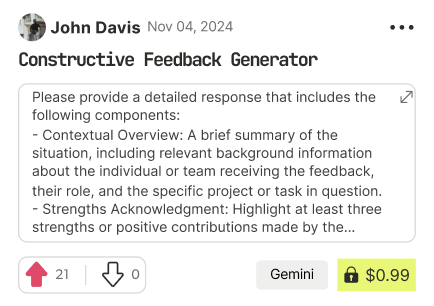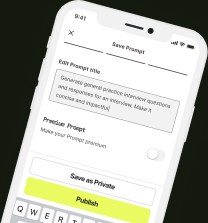prompt mine App
Find, Create & Share AI Magic
Chaos Aligned: Engineering Your Wolf Rhythm
Based on your description, it's clear you're caught in a conflict between your inherent biological timing and external expectations or internal attempts to conform to an 'early bird' ideal. Let's decode your biological signals to build a framework that supports, rather than fights, your natural rhythm.
Chronotype Analysis: Your likely biological archetype and the underlying pattern of your hormonal/cognitive cycle.
Your pattern of early natural waking (5-6 AM) combined with morning fog until coffee (~8 AM), an afternoon energy crash (falling asleep during meditation), and significant late-night creative surges points towards a complex profile, likely a Wolf chronotype that is currently experiencing circadian disruption.
Underlying Wolf Tendency: The late-night creative energy and morning fogginess are classic markers of a Wolf (or Owl) – someone whose melatonin production is delayed, leading to later sleep onset and peak alertness/creativity occurring later in the evening or even at night. Cortisol levels might be lower upon waking and rise more slowly than in earlier chronotypes, explaining the morning fog. Dopamine activity might also be more elevated in the evening hours.
Conflicting Early Wake: The natural early wake time (5-6 AM), while superficially resembling a Lion or Bear, is likely a symptom of fragmented or insufficient sleep driven by the underlying Wolf pattern and the fight against it. Going to bed at 22:30 when your brain is hitting a creative peak means you're attempting to initiate sleep when your biological signals (elevated cortisol/dopamine, suppressed melatonin) are promoting wakefulness. This leads to poor sleep quality, accumulation of sleep pressure, and the feeling of being "exhausted but can't sleep." This chronic misalignment exacerbates morning fog and afternoon crashes.
Your biological model currently looks like: low cognitive function & energy upon waking, slow rise peaking late morning/midday (boosted by stimulants/exercise), significant dip mid-afternoon, and a paradoxical surge of creative energy and wakefulness late evening, clashing with desired sleep.
Routine Conflict Report: Specific parts of your day currently misaligned with your biology, and why they’re harming performance.
1. Attempting Sleep by 22:30: Forcing bedtime when your brain is biologically primed for wakefulness and creativity (likely due to peak dopamine/cortisol activity and delayed melatonin) leads to increased sleep latency (time taken to fall asleep) and frustration. This is the core conflict causing you to feel like a "bad sleeper." Your internal clock is saying "be creative," while you're trying to force "sleep," resulting in poor sleep initiation and contributing to early, non-restorative wake-ups.
2. Morning Exercise Immediately Upon Waking (5-6 AM): While exercise is beneficial, performing strenuous activity when cortisol might be at its lowest point for the day (contributing to the foggy feeling) and body temperature is still low isn't leveraging your biological peaks. It provides a short-lived boost because it's artificially stimulating the system rather than riding a natural wave of rising energy and cognitive function. Doing this before sufficient light exposure further disrupts circadian signaling.
3. Afternoon Meditation: Falling asleep during afternoon meditation is a clear signal that this time slot is hitting a low point in your ultradian and circadian cycles, amplified by likely chronic sleep debt. This isn't a window for focused mindfulness; it's a window signaling an urgent need for recovery. Trying to meditate here is like trying to run a marathon during a forced break – your body is demanding rest.
Chaos Aligned Framework: Your optimized daily schedule mapped to your biological windows.
This framework is designed to gently shift your late tendencies while optimizing the rhythm you currently have, reducing the internal fight. It prioritizes flexibility and tuning into your actual energy state.
5:30 AM - 6:30 AM: Emergence & Low-Demand Start
Focus: Gradual awakening. Avoid immediate bright light or screens. Hydrate.
Tasks: This is your toddler-free buffer. Gentle movement (stretching, quiet walk if possible) and your meditation ritual fit here. The goal is presence, not high performance.
6:30 AM onwards: Toddler & Gentle Transition
Focus: Family time, allowing biological wakefulness cues (light exposure) to take effect naturally.
Tasks: Low-cognitive load activities – getting ready, breakfast. Delay caffeine intake slightly past waking (aim for 60-90 mins after waking) to allow natural cortisol rise, if any, or time it strategically before your first focus block.
9:00 AM - 11:00 AM: Rising Cognitive Wave - Analytical/Logical
Focus: As morning fog lifts and energy rises (potentially aided by timed caffeine), this is your prime window for tasks requiring concentration, analysis, and logical thinking.
Tasks: Deep work on complex problems, writing reports, strategic planning, critical decision-making.
11:00 AM - 12:30 PM: Movement & Transition
Focus: Physical energy peak potential.
Tasks: Shift your exercise here. A vigorous workout leverages rising energy and provides a sustained boost before the afternoon dip. Alternatively, a brisk walk or movement break.
12:30 PM - 1:30 PM: Fuel & Recovery
Focus: Nourishment and rest.
Tasks: Mindful lunch. Avoid heavy meals that exacerbate post-lunch slump.
1:30 PM - 3:00 PM: The Dip Zone - Admin & Low Focus
Focus: Acknowledging the energy dip.
Tasks: Process emails, routine administrative work, scheduling, organizing files, simple tasks that don't require high cognitive function.
3:00 PM - 4:00 PM: Strategic Recharge
Focus: Proactive recovery to mitigate the crash.
Tasks: Instead of fighting sleep during meditation, allow for rest. This could be a 20-30 minute power nap if feasible, or Non-Sleep Deep Rest (NSDR) like Yoga Nidra, or simply quiet rest with eyes closed. This is crucial for restoring capacity for the later part of the day.
4:00 PM - 6:00 PM: Post-Dip - Social & Moderate Focus
Focus: Energy may slightly rebound or stabilize. Suitable for interaction and less demanding cognitive tasks.
Tasks: Meetings, collaboration, phone calls, creative brainstorming that doesn't require intense output, planning for the next day.
6:00 PM - 8:00 PM: Transition & Connection
Focus: Winding down work, connecting with family.
Tasks: Dinner, family time, light household tasks, gentle movement (evening stroll).
8:00 PM - 10:00 PM: The Biological Wind-Down Window
Focus: Signaling to your body that sleep is approaching. Dim lights significantly (especially blue light). Avoid screens if possible, or use blue-light filters.
Tasks: Reading, quiet conversation, journaling, gentle stretching. Crucially, shift your creative energy away from stimulating activities. If a creative surge hits, capture ideas non-digitally (notebook) or engage in low-stimulus creative planning rather than execution.
10:00 PM onwards: Target Sleep Initiation
Focus: Transitioning into sleep. Aim for bed when genuine sleep signals are present, rather than a fixed time you're fighting. Given your late surge, aiming for 10:30 PM or even 11:00 PM initially might be more realistic and lead to better quality sleep than fighting for 22:30. Observe when sleepiness actually arrives.
Adaptive Rituals: Flexible anchors that adjust to your energy and mood fluctuations.
1. Light-Aligned Wake Ritual: Instead of relying solely on an alarm, use a dawn simulator alarm set to your earliest necessary wake time (before toddler). Once awake, get natural light exposure as soon as possible after the initial foggy period begins to lift, not immediately upon opening your eyes in darkness. On days without the toddler constraint, allow yourself to wake slightly later if biologically possible, guided by light.
2. Midday Energy Audit & Adaptive Recovery: Around 1-2 PM, pause and honestly assess your energy level (e.g., on a scale of 1-5). If it's below a 3, prioritize the strategic recharge (nap/NSDR) over forcing continued work or a traditional meditation that becomes a sleep struggle. If energy is higher, use the time for a walk or light activity.
3. Evening Signal Setting: Start dimming lights and reducing stimulating inputs (screens, intense conversations, work) consistently around 8 PM, regardless of how you feel. This is a non-negotiable signal to your biology. What you do within this window (reading, quiet chat, light journaling) is flexible based on mood, but the environmental shift is the anchor.
4. Variable Creative Capture: If late-night creative surges persist as you adjust, have a dedicated notebook or voice recorder away from screens. Instead of doing the work, capture the ideas for processing during your prime analytical window the next day. This honors the creativity without sacrificing sleep.
Implementation Plan: Clear steps to transition into your new schedule, including experimentation and refinement tactics.
1. Observation Phase (3-5 days): Before making drastic changes, track your actual timing without trying to change it. Note:
Actual sleep onset time (when you think you fall asleep).
Actual wake time.
Timing of morning fog lifting/first feeling alert.
Timing and intensity of afternoon dip.
Timing and nature of evening creative surges.
When you naturally feel tired enough for sleep.
This confirms your current rhythm baseline.
2. Gradual Shift (1-2 weeks per change): Don't overhaul everything at once.
Prioritize Sleep Initiation: Focus on the evening wind-down and later target bedtime (10:30/11 PM). Implement the dimming lights/screen reduction ritual consistently for a week. Observe if sleep latency improves and if the creative surge timing shifts slightly earlier or becomes less intense.
Relocate Exercise: Shift your morning exercise to the 11 AM - 12:30 PM window for a week. Note if the energy boost is more sustained and if morning fog clears more naturally without the immediate exertion.
Implement Strategic Recharge: Introduce the 3:00-4:00 PM rest period (nap/NSDR) for a week. Track if it reduces the evening exhaustion and your need for late-night stimulation to stay awake.
3. Experiment & Tune:
Caffeine Timing: Experiment with the timing of your first coffee – immediately after waking vs. 60-90 mins later vs. right before your 9 AM focus block. Note the difference in fog lifting and sustained energy.
Creative Capture: Consistently use the low-stimulus creative capture method in the evening. See if transferring ideas to your analytical window the next day allows you to leverage them effectively without sacrificing sleep.
4. Track & Refine: Keep a simple log (journal, app) tracking:
Target vs. Actual Bedtime & Wake Time
Estimated Sleep Latency (how long to fall asleep)
Subjective Sleep Quality (e.g., 1-5)
Subjective Energy Levels (e.g., 1-5) at 9 AM, 1 PM, 4 PM, 8 PM
Notes on when peak focus or creative energy occurred.
This data is gold for understanding how your biology is responding and where further fine-tuning is needed. Your chronotype isn't static; it shifts slightly with age, season, and lifestyle. Continuous, adaptive tracking is key.
5. Be Patient: Shifting circadian rhythms takes time (days to weeks). There will be days the framework feels off. This is normal. Use the adaptive rituals (energy checks, flexible tasks) to navigate these fluctuations rather than abandoning the structure entirely. This isn't about strict adherence; it's about intelligent alignment.
This framework honors your probable Wolf pattern while addressing the current state of misalignment causing your "bad sleep." By working with your later energy peaks and strategically managing the dips and transitions, you can move towards more restorative sleep and sustained performance throughout your unique day.

Chaos Aligned: Engineering Your Wolf Rhythm


Find Powerful AI Prompts
Discover, create, and customize prompts with different models, from ChatGPT to Gemini in seconds

Simple Yet Powerful
Start with an idea and use expert prompts to bring your vision to life!